
|
|
Font Size:
|
||||
|
|
|
|
||||
STATISTICAL BRIEF #148:
A Comparison of Person Characteristics and Reported Conditions for Adult Medicare Beneficiaries with High and Low Annual Prescription Medicine Expenditures, 2003
Highlights
- In 2003, the top 1 percent of the Medicare population age 18 and older (that is the 1 percent of the population with the highest prescription drug spending) accounted for nearly 10 percent of total prescribed drug spending (9.8 percent) by adult Medicare beneficiaries.
- During 2003, adult Medicare beneficiaries who were poor accounted for a greater proportion in the top 10 percent of the prescribed drug expenditure distribution (18.9 percent) than in the lower 50 percent (12.8 percent).
- Adult beneficiaries in fair or poor health accounted for a higher proportion in the top 10 percent of the prescribed drug expenditure distribution than in the lower 50 percent (55.5 percent versus 20.8 percent) in 2003.
- In 2003, a higher proportion of adult Medicare beneficiaries in the top 10 percent of the prescribed drug expenditure distribution reported having diabetes (38.6 percent), heart disease (52.7 percent), high blood pressure (78.2 percent) and asthma (23.2 percent) than the proportion in the lower 50 percent (7.1 percent, 16.7 percent, 45.4 percent, and 6.0 percent); moreover, approximately four times the proportion in the top 10 percent than in the lower 50 percent reported 2 or more of these conditions (65.5 percent versus 14.9 percent), and approximately nine times the proportion in the top 10 percent than in the lower 50 percent reported 3 or more of these conditions (27.7 percent versus 2.9 percent).
Introduction
This Statistical Brief presents 2003 data for the U.S. civilian noninstitutionalized (community) population from the Household Component of the Medical Expenditure Panel Survey (MEPS-HC). The brief compares selected sociodemographic person characteristics and reported chronic conditions for adult Medicare beneficiaries in the top 10 percent (the 10 percent of the population with the highest prescription drug spending) with those in the lower 50 percent (the 50 percent of the population with the lowest prescription drug spending) of the prescribed medicine expenditure distribution.
Only prescribed medicines purchases in an outpatient setting are included in the estimates provided in this brief. Insulin and diabetic supplies and equipment are included in MEPS prescribed medicines estimates. Over-the-counter medicines are excluded from these estimates as are prescription medicines administered in an inpatient setting or in a clinic or physician's office. All differences discussed in the text are statistically significant at the 0.05 level.
Findings
In 2003, the 41.2 million Medicare beneficiaries age 18 and older in the U.S. civilian noninstitutionalized population had $74.9 billion in annual prescribed medicine expenditures. The top 1 percent (that is, the 1 percent of the population with the highest prescription drug spending) accounted for approximately 10 percent (9.8 percent) of annual prescription drug expenditures by the adult Medicare population. The top 5 percent accounted for just over one-quarter of all prescription drug spending by adult Medicare beneficiaries (26.2 percent), and the top 10 percent accounted for two-fifths of total drug spending (40.2 percent). The lower 50 percent (that is, the 50 percent of the population with the lowest prescription drug spending) accounted for approximately 11 percent of all prescription medicine expenditures by adult Medicare beneficiaries (10.7 percent) while the top 50 percent accounted for nearly 90 percent (89.3 percent). (figure 1)
During 2003, Medicare beneficiaries age 18-64 accounted for a higher proportion in the top 10 percent of the prescribed drug expenditure distribution (26.1 percent) than in the lower 50 percent of the distribution (10.3 percent). Medicare beneficiaries age 80 and older and age 65-79 accounted for higher proportions in the lower 50 percent (23.1 percent and 66.6 percent, respectively) than in the top 10 percent (18.0 percent and 55.9 percent, respectively) of the distribution. (figure 2)
For adult Medicare beneficiaries in 2003, white non-Hispanics (81.3 percent and 78.4 percent), black non-Hispanics (11.2 percent and 10.1 percent), and other non-Hispanics (3.1 percent and 4.4 percent) did not have a significant difference in the proportion they represented in the top 10 percent or the lower 50 percent of the prescribed drug expenditure distribution. Hispanics, however, accounted for a higher proportion in the lower 50 percent (7.1 percent) than in the top 10 percent (4.4 percent) of the expenditure distribution. (figure 3)
A higher proportion of adult Medicare beneficiaries in the top 10 percent of prescribed medicine expenditure distribution were beneficiaries with Medicare and additional public insurance only (25.6 percent) than the proportion in the lower 50 percent (14.0 percent) in 2003. In addition, there was a smaller proportion of beneficiaries in the top 10 percent of the prescribed drug expenditure distribution with Medicare only (24.5 percent) than in the lower 50 percent (32.1 percent). There was no significant difference in the proportion of Medicare beneficiaries in the top 10 percent and lower 50 percent of the prescribed drug expenditure distribution when looking at those with Medicare and private insurance. (figure 4)
During 2003, a higher proportion of adult Medicare beneficiaries in the top 10 percent (18.9 percent) than in the lower 50 percent (12.8 percent) of the prescribed medicine expenditure distribution were poor. Medicare beneficiaries with medium and high incomes accounted for a lesser proportion in the top 10 percent of the distribution (51.5 percent) than in the lower 50 percent (59.3 percent). (figure 5)
In 2003, adult Medicare beneficiaries in excellent, very good, or good health accounted for a lower proportion in the top 10 percent of the prescribed medicine expenditure distribution than the lower 50 percent (44.5 percent and 79.2 percent, respectively). Conversely, those adult beneficiaries in fair or poor health accounted for a higher proportion in the top 10 percent (55.5 percent) of the prescribed drug expenditure distribution than in the lower 50 percent (20.8 percent). (figure 6)
In 2003, a higher proportion of Medicare beneficiaries age 18 and older in the top 10 percent of the prescribed drug expenditure distribution reported having diabetes (38.6 percent), heart disease (52.7 percent), high blood pressure (78.2 percent), and asthma (23.2 percent) than in the lower 50 percent of the expenditure distribution (7.1 percent, 16.7 percent, 45.4 percent, and 6.0 percent, respectively). Furthermore, approximately four times the proportion in the top 10 percent than in the lower 50 percent reported two or more of these conditions (65.5 percent versus 14.9 percent) and approximately nine times the proportion in the top 10 percent than in the lower 50 percent reported three or more of these conditions (27.7 percent versus 2.9 percent). (figure 7)
Definitions
Medicare population
People are considered Medicare beneficiaries if they ever report being covered by Medicare while in the survey. Only Medicare beneficiaries age 18 and older are included in this analysis.
Age
Age is the last available age for the sampled person. For most persons, this was their age at the end of the year.
Racial and ethnic classifications
Classification by race and ethnicity was based on information reported for each family member. Respondents were asked if each family member's race was best described as American Indian, Alaska Native, Asian or Pacific Islander, black, white, or other. They also were asked if each family member's main national origin or ancestry was Puerto Rican; Cuban; Mexican, Mexicano, Mexican American, or Chicano; other Latin American; or other Spanish. All persons whose main national origin or ancestry was reported in one of these Hispanic groups, regardless of racial background, were classified as Hispanic. Since the Hispanic grouping can include black Hispanic, white Hispanic, Asian and Pacific Islanders Hispanic, and other Hispanic, the race categories of black, white, Asian and Pacific Islanders, and other do not include Hispanic. Beginning in 2002, MEPS respondents who reported other single or multiple races were included in the other non-Hispanic category.
Health insurance status
Respondents were asked about health insurance coverage for themselves and all household members at each round of interviewing. The insurance variables reflect supplemental coverage, in addition to Medicare, that beneficiaries had for hospital and physician services. Persons categorized as having supplemental insurance coverage may or may not have coverage for prescription drugs. The insurance categories are mutually exclusive and hierarchical. Persons with more than one type of supplemental coverage were placed into an insurance category in the following order:
- Medicare and private insurance: This category includes persons classified as Medicare beneficiaries and covered by Medicare and a supplementary private policy.
- Medicare and other public insurance: This category includes persons classified as Medicare beneficiaries who met both of the following criteria: 1) they were not covered by private insurance at any point during the year, and 2) they were covered by one of the following public programs at any point during the year: Medicaid, other public hospital/physician coverage.
- Medicare HMO/Medicare only: This category includes persons classified as Medicare beneficiaries but not classified as Medicare and private insurance or as Medicare and other public insurance. This group includes persons who were enrolled in Medicare HMOs and persons who had Medicare fee-for-service coverage only.
Each year, persons were classified according to their family's income in terms of poverty status. In this report, poverty status is the ratio of the family's income to the Federal poverty thresholds, which control for the size of the family and the age of the head of the family. The following classification of poverty status was used:
- Poor: Persons in families with income less than 100 percent of the poverty line, including those who reported negative income.
- Near poor/low income: Persons in families with income of 100 percent of the poverty line through 200 percent of the poverty line.
- Middle income/high income: Persons in families with income over 200 percent of the poverty line.
During each round of interviewing, the household respondent was asked to rate the health of each person in the family according to the following categories: excellent, very good, good, fair, or poor. For this report, the response categories "excellent," "very good," and "good" were collapsed, as were "fair" and "poor." Health status was missing for approximately 1 percent of adult Medicare beneficiaries.
Condition data
During rounds 3 and 5 of household interviewing for persons age 18 and older, the household respondent was asked: "Has person ever been told by a doctor or other health professional that person has <condition>?" Please note, heart disease includes people answering "yes" to at least one of the following conditions: coronary heart disease, angina (or angina pectoris), heart attack (or myocardial infarction or MI), or any other heart condition or heart disease, other than coronary heart disease, angina, or heart attack. The condition data included in this brief was missing for approximately 5 percent of the adult Medicare population, approximately 1 percent of the top 10 percent of the adult Medicare population, and approximately 7 percent of the lower 50 percent of the adult Medicare population.
About MEPS-HC
MEPS-HC is a nationally representative longitudinal survey that collects detailed information on health care utilization and expenditures, health insurance, and health status, as well as a wide variety of social, demographic, and economic characteristics for the civilian noninstitutionalized population. It is cosponsored by the Agency for Healthcare Research and Quality and the National Center for Health Statistics.
For more information about MEPS, call the MEPS information coordinator at AHRQ (301-427-1656) or visit the MEPS Web site at http://www.meps.ahrq.gov/.
References
For a detailed description of the MEPS survey design, sample design, and methods used to minimize sources of nonsampling error, see the following publications:
Cohen, J. Design and Methods of the Medical Expenditure Panel Survey Household Component. MEPS Methodology Report No. 1. AHCPR Pub. No. 97-0026. Rockville, Md.: Agency for Health Care Policy and Research, 1997.
Cohen, S. Sample Design of the 1996 Medical Expenditure Panel Survey Household Component. MEPS Methodology Report No. 2. AHCPR Pub. No. 97-0027. Rockville, Md.: Agency for Health Care Policy and Research, 1997.
Cohen, S. Design Strategies and Innovations in the Medical Expenditure Panel Survey. Medical Care, July 2003: 41(7) Supplement: III-5-III-12.
Suggested Citation
Stagnitti, M. N. A Comparison of Person Characteristics and Reported Conditions for Adult Medicare Beneficiaries with High and Low Annual Prescription Medicine Expenditures, 2003. Statistical Brief #148. November 2006. Agency for Healthcare Research and Quality, Rockville, Md. http://www.meps.ahrq.gov/mepsweb/data_files/publications/st148/stat148.shtml
AHRQ welcomes questions and comments from readers of this publication who are interested in obtaining more information about access, cost, use, financing, and quality of health care in the United States. We also invite you to tell us how you are using this Statistical Brief and other MEPS data and tools and to share suggestions on how MEPS products might be enhanced to further meet your needs. Please e-mail us at mepspd@ahrq.gov or send a letter to the address below:
Steven B. Cohen, PhD, Director
Center for Financing, Access, and Cost Trends
Agency for Healthcare Research and Quality
540 Gaither Road
Rockville, MD 20850
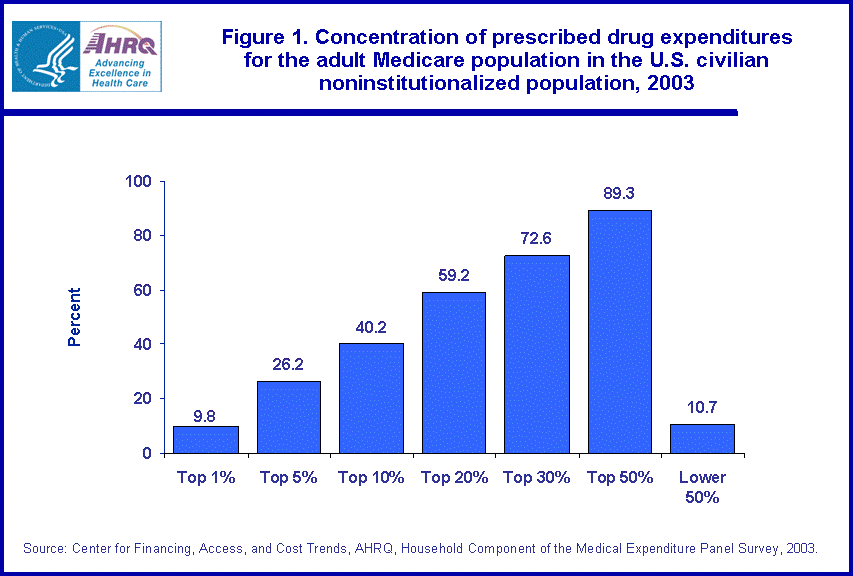 |
||||||||||||||||||||||||||||||||||||||||||
|
||||||||||||||||||||||||||||||||||||||||||
|
|
||||||||||||||||||||||||||||||||||||||||||
 |
||||||||||||||||||||||||||||||||||||||||||
|
||||||||||||||||||||||||||||||||||||||||||
|
|
||||||||||||||||||||||||||||||||||||||||||
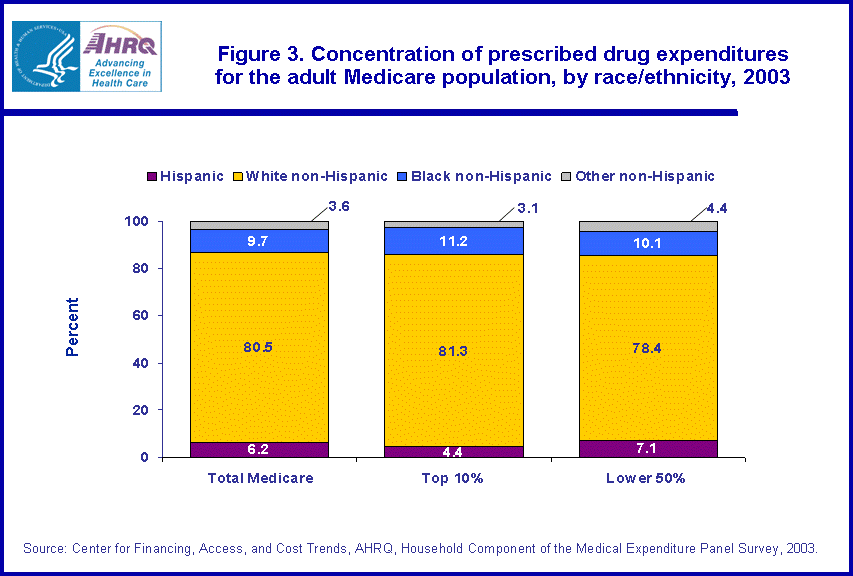 |
||||||||||||||||||||||||||||||||||||||||||
|
||||||||||||||||||||||||||||||||||||||||||
|
|
||||||||||||||||||||||||||||||||||||||||||
 |
||||||||||||||||||||||||||||||||||||||||||
|
||||||||||||||||||||||||||||||||||||||||||
|
|
||||||||||||||||||||||||||||||||||||||||||
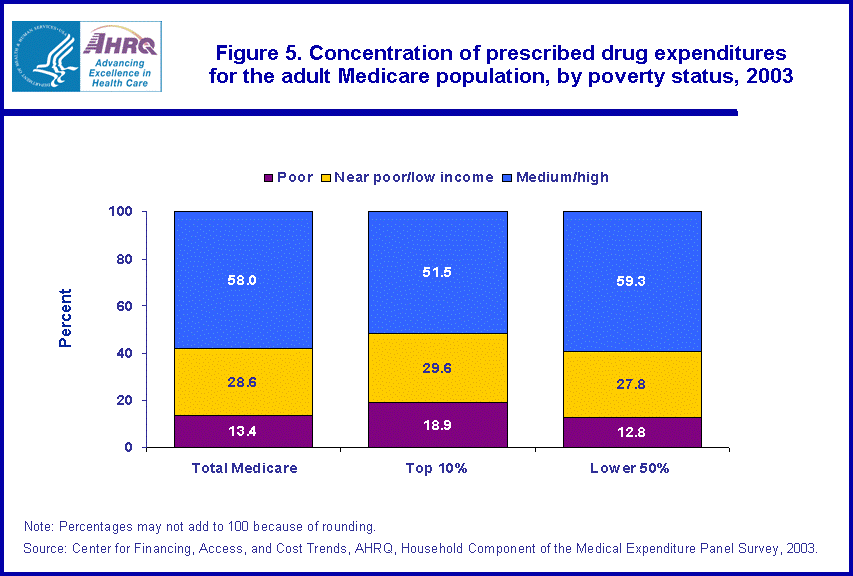 |
||||||||||||||||||||||||||||||||||||||||||
|
||||||||||||||||||||||||||||||||||||||||||
|
|
||||||||||||||||||||||||||||||||||||||||||
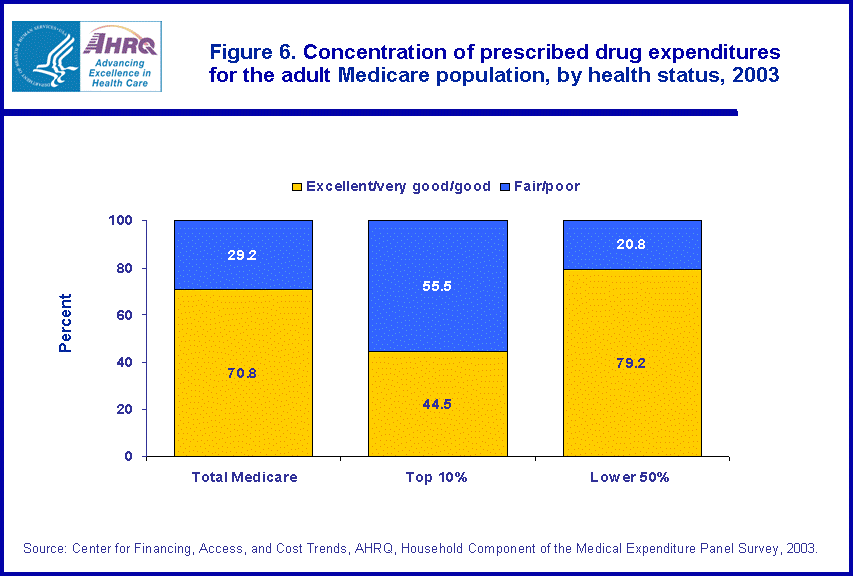 |
||||||||||||||||||||||||||||||||||||||||||
|
||||||||||||||||||||||||||||||||||||||||||
|
|
||||||||||||||||||||||||||||||||||||||||||
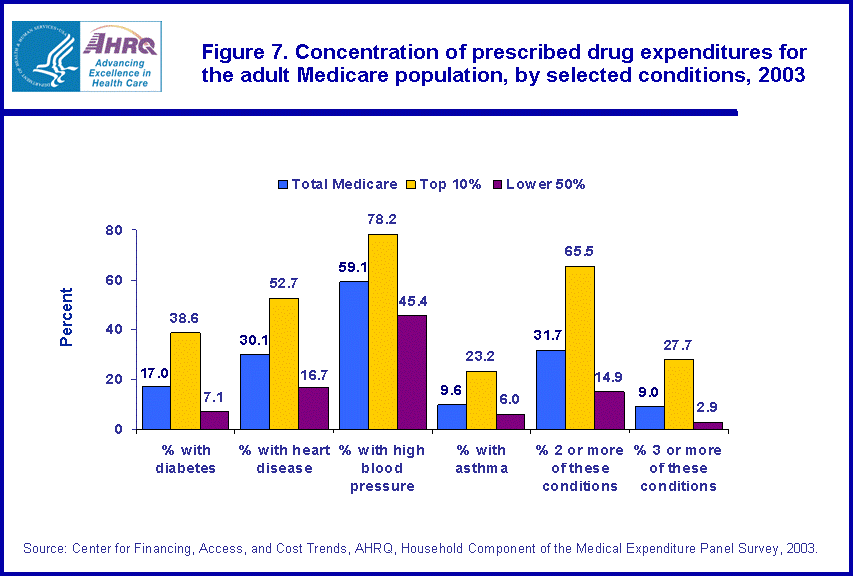 |
||||||||||||||||||||||||||||||||||||||||||
|
||||||||||||||||||||||||||||||||||||||||||
|
|
||||||||||||||||||||||||||||||||||||||||||


